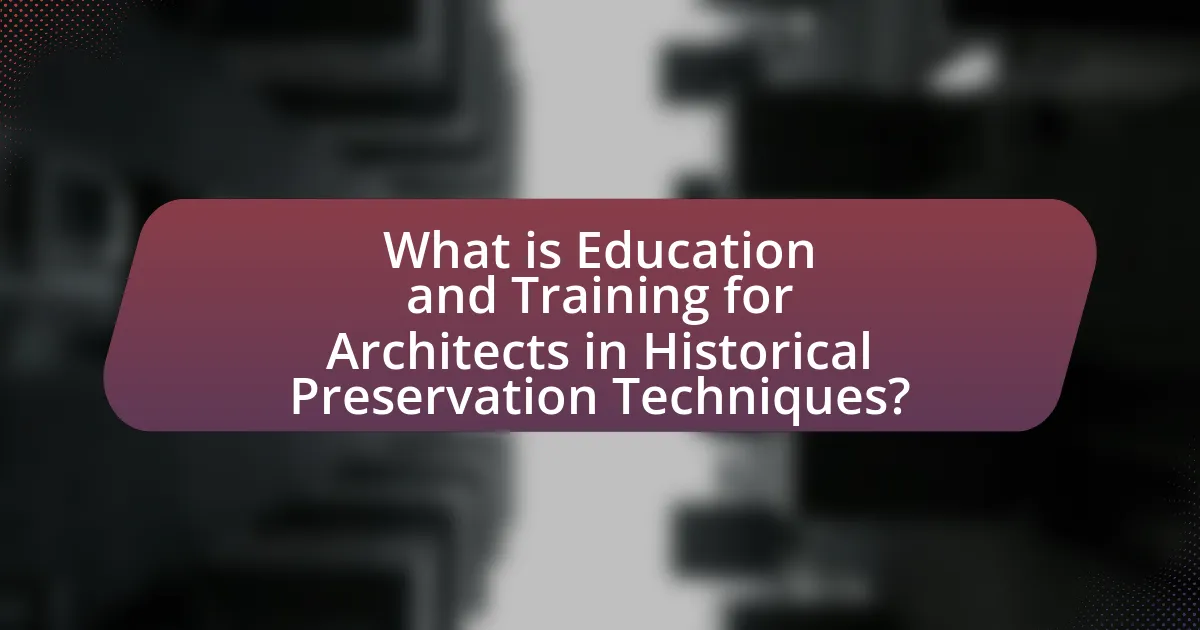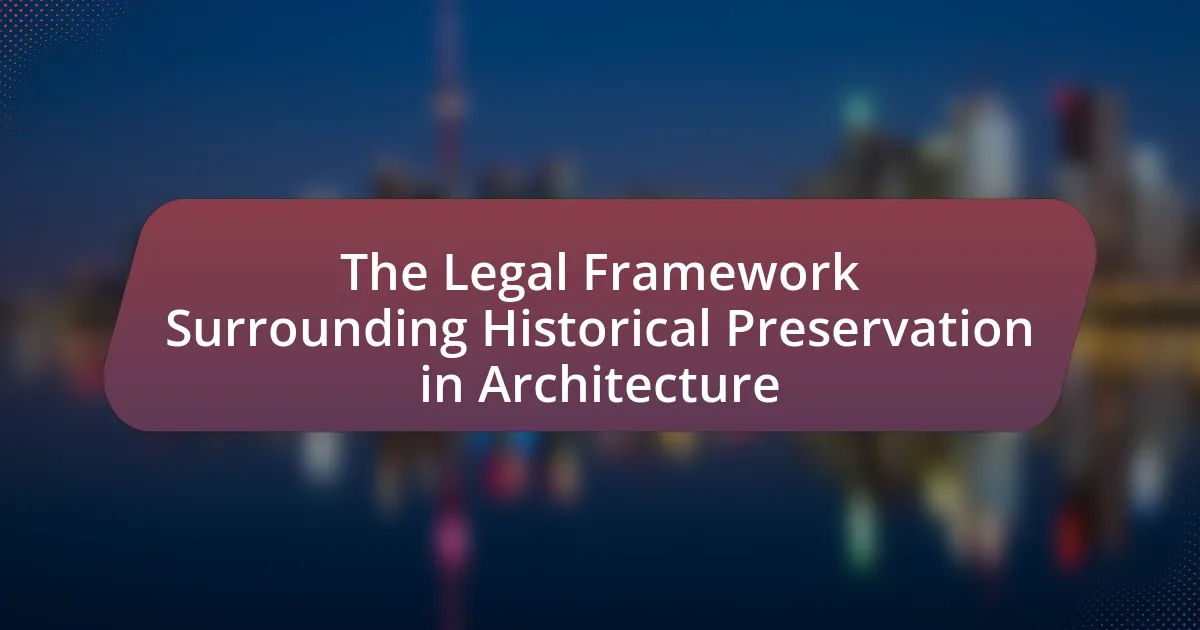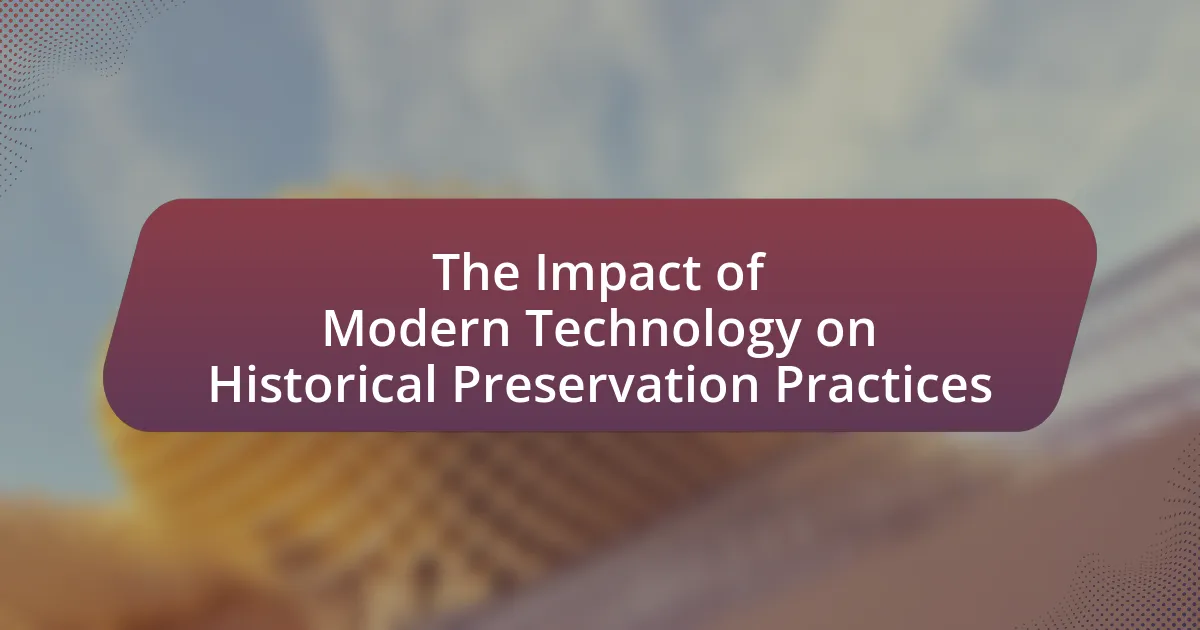Education and training for architects in historical preservation techniques encompass specialized programs designed to equip professionals with essential skills for conserving and restoring historic buildings. These programs include coursework in architectural history, conservation methods, materials science, and legal frameworks, emphasizing the importance of understanding historical context and preservation ethics. Key components of training involve mastering conservation techniques, documentation skills, and project management, while practical experiences enhance learning through hands-on opportunities. The article also addresses the challenges educators face, the impact of evolving technologies, and the significance of interdisciplinary collaboration in preparing architects for effective preservation practices.

What is Education and Training for Architects in Historical Preservation Techniques?
Education and training for architects in historical preservation techniques involve specialized programs that equip professionals with the skills necessary to conserve and restore historic buildings. These programs typically include coursework in architectural history, conservation methods, materials science, and legal frameworks governing preservation. For instance, the National Council of Architectural Registration Boards (NCARB) emphasizes the importance of understanding historical context and preservation ethics as part of architectural education. Additionally, many universities offer master’s degrees in historic preservation, which provide hands-on experience through internships and projects focused on real-world preservation challenges.
Why is education important for architects specializing in historical preservation?
Education is crucial for architects specializing in historical preservation because it equips them with the necessary knowledge and skills to understand, analyze, and restore historical structures accurately. This specialized education covers architectural history, preservation techniques, and materials science, enabling architects to make informed decisions that respect the integrity of historical sites. For instance, a study by the National Trust for Historic Preservation highlights that architects with formal training in preservation are more adept at identifying the unique characteristics of historical buildings, which is essential for maintaining their authenticity and cultural significance.
What foundational knowledge do architects need in historical preservation?
Architects need foundational knowledge in historical preservation that includes an understanding of architectural history, preservation theory, and building materials. This knowledge allows architects to assess the significance of historical structures, apply appropriate preservation techniques, and ensure compliance with legal regulations such as the National Historic Preservation Act. Familiarity with restoration methods, conservation ethics, and the historical context of buildings is essential for making informed decisions that respect the integrity of the original design while accommodating modern needs.
How does historical context influence architectural education?
Historical context significantly influences architectural education by shaping the curriculum, design philosophies, and preservation techniques taught to students. Architectural education incorporates historical styles, materials, and methods that reflect the cultural and technological advancements of specific periods, ensuring that future architects understand the evolution of built environments. For instance, the inclusion of classical architecture in educational programs stems from its historical significance and impact on contemporary design practices. Furthermore, educational institutions often emphasize the importance of local architectural heritage, which is informed by historical context, to foster a sense of identity and responsibility among students. This approach is supported by studies indicating that understanding historical context enhances students’ ability to engage with and preserve architectural heritage effectively.
What are the key components of training in historical preservation techniques?
The key components of training in historical preservation techniques include understanding architectural history, mastering conservation methods, and developing skills in documentation and analysis. Architectural history provides a foundational knowledge of styles, materials, and construction methods relevant to preservation. Conservation methods encompass techniques for repairing and maintaining historic structures while adhering to ethical standards. Skills in documentation and analysis involve creating detailed records of existing conditions and assessing the significance of historical elements, which are essential for informed decision-making in preservation projects.
What specific skills are taught in historical preservation programs?
Historical preservation programs teach skills such as architectural history, conservation techniques, materials science, and project management. These programs equip students with the ability to assess and document historical structures, understand the significance of various architectural styles, and apply appropriate preservation methods. For instance, knowledge of materials science is crucial for selecting compatible materials for restoration, ensuring the integrity of the original structure is maintained. Additionally, project management skills are essential for overseeing preservation projects, which often involve coordinating with various stakeholders, including government agencies and community organizations.
How do practical experiences enhance learning in this field?
Practical experiences enhance learning in the field of historical preservation techniques by providing hands-on opportunities that reinforce theoretical knowledge. Engaging in real-world projects allows architects to apply concepts learned in the classroom, such as materials conservation and restoration methods, directly to tangible situations. For instance, a study by the National Trust for Historic Preservation found that students who participated in fieldwork reported a 30% increase in their understanding of preservation practices compared to those who only received traditional instruction. This experiential learning fosters critical thinking, problem-solving skills, and a deeper appreciation for the complexities involved in preserving historical structures.
What challenges do educators face in teaching historical preservation?
Educators face several challenges in teaching historical preservation, primarily due to the complexity of the subject matter and the need for interdisciplinary knowledge. The integration of history, architecture, and conservation science requires educators to possess a broad understanding of various fields, which can be difficult to convey effectively to students. Additionally, the rapid advancement of technology in preservation techniques necessitates continuous updates to curricula, making it challenging for educators to stay current. Limited resources and funding for practical training opportunities further hinder the ability to provide hands-on experiences essential for understanding preservation practices. According to a study by the National Trust for Historic Preservation, 70% of educators reported a lack of adequate funding as a significant barrier to teaching effective preservation methods.
How do evolving technologies impact historical preservation education?
Evolving technologies significantly enhance historical preservation education by providing innovative tools and methods for teaching and learning. For instance, the use of 3D modeling software allows students to visualize and analyze historical structures in detail, facilitating a deeper understanding of architectural techniques and materials used in the past. Additionally, virtual reality (VR) and augmented reality (AR) technologies enable immersive experiences, allowing students to explore historical sites and understand their context without physical constraints. Research indicates that these technologies improve engagement and retention rates among students, as interactive learning environments have been shown to increase knowledge acquisition by up to 75%. Furthermore, digital documentation tools, such as laser scanning and photogrammetry, enable precise recording of historical sites, which can be used for educational purposes and preservation efforts. These advancements collectively contribute to a more effective and comprehensive educational framework for architects specializing in historical preservation.
What resources are available for educators in this field?
Educators in the field of historical preservation techniques for architects have access to various resources, including specialized training programs, online courses, and professional organizations. Institutions such as the National Council for Preservation Education provide curriculum guidelines and resources tailored for educators. Additionally, platforms like Coursera and edX offer courses on preservation techniques, allowing educators to enhance their teaching materials. Professional organizations, such as the American Institute for Conservation, provide access to publications, workshops, and networking opportunities that support educators in staying current with best practices and advancements in the field.

How do different educational pathways influence architects in historical preservation?
Different educational pathways significantly influence architects in historical preservation by shaping their knowledge base, skill set, and approach to conservation practices. For instance, architects who pursue specialized degrees in historic preservation or conservation gain in-depth understanding of restoration techniques, materials, and historical context, which are crucial for maintaining the integrity of heritage sites. In contrast, architects with a general architecture degree may lack specific training in preservation methods, potentially leading to less effective conservation efforts. Research indicates that programs emphasizing interdisciplinary studies, such as those combining architecture with history and cultural studies, enhance architects’ ability to navigate the complexities of preserving historical structures, as they develop a holistic view of the built environment and its cultural significance.
What types of degrees are available for aspiring architects in historical preservation?
Aspiring architects in historical preservation can pursue several types of degrees, including a Bachelor of Architecture, a Master of Architecture with a focus on historic preservation, and specialized degrees such as a Master of Science in Historic Preservation. These programs typically cover architectural design, conservation techniques, and the history of architecture, equipping students with the necessary skills to work on preserving historical structures. For instance, the National Council of Architectural Registration Boards recognizes the importance of accredited programs that include preservation studies, ensuring that graduates are well-prepared for careers in this field.
How do undergraduate programs differ from graduate programs in this field?
Undergraduate programs in historical preservation techniques focus on foundational knowledge and skills, while graduate programs emphasize advanced study and specialization. Undergraduate curricula typically cover broad topics such as architectural history, materials conservation, and basic preservation methods, providing students with a comprehensive introduction to the field. In contrast, graduate programs delve deeper into specific areas, such as legal frameworks, advanced restoration techniques, and research methodologies, often requiring a thesis or capstone project that demonstrates mastery of complex concepts. This distinction is supported by the fact that undergraduate degrees generally require fewer credit hours and less intensive coursework compared to graduate degrees, which demand a higher level of critical thinking and independent research.
What role do certifications play in an architect’s career in historical preservation?
Certifications play a crucial role in an architect’s career in historical preservation by validating their expertise and knowledge in specialized preservation techniques. These certifications, such as those offered by the National Council for Preservation Education, demonstrate an architect’s commitment to preserving historical integrity and adhering to established standards. Furthermore, certified architects often gain access to exclusive projects and funding opportunities, as many organizations and government entities prefer or require certified professionals for preservation work. This enhances their credibility and marketability in a competitive field, ultimately contributing to their professional growth and success.
How do internships and apprenticeships contribute to an architect’s education?
Internships and apprenticeships significantly enhance an architect’s education by providing practical, hands-on experience in real-world settings. These opportunities allow aspiring architects to apply theoretical knowledge gained in academic settings to actual projects, fostering a deeper understanding of design principles, construction methods, and client interactions. According to the National Architectural Accrediting Board, practical experience is essential for developing competencies required for professional practice, as it bridges the gap between classroom learning and the complexities of architectural work. Furthermore, internships and apprenticeships often involve mentorship from experienced professionals, which can lead to valuable networking opportunities and insights into industry standards and practices.
What are the benefits of hands-on experience in historical preservation?
Hands-on experience in historical preservation provides practical skills and a deeper understanding of preservation techniques. This experiential learning allows architects to engage directly with materials, tools, and methods used in the restoration and conservation of historical sites. For instance, working on actual projects enables architects to apply theoretical knowledge, enhancing their problem-solving abilities in real-world scenarios. Additionally, hands-on experience fosters a greater appreciation for historical context and craftsmanship, which is crucial for maintaining the integrity of heritage structures. Studies have shown that practitioners with hands-on training are more adept at identifying preservation challenges and implementing effective solutions, ultimately leading to higher quality outcomes in preservation projects.
How can networking during training enhance career opportunities?
Networking during training enhances career opportunities by facilitating connections with industry professionals, mentors, and peers who can provide guidance, job leads, and collaborative opportunities. Engaging with established architects and preservationists during training allows individuals to gain insights into the field, access exclusive job openings, and receive recommendations that can significantly improve their employability. Research indicates that approximately 70% of jobs are found through networking, highlighting its critical role in career advancement within specialized fields like historical preservation.

What are the best practices for ongoing education in historical preservation techniques?
The best practices for ongoing education in historical preservation techniques include participation in workshops, attending conferences, and engaging in online courses. Workshops provide hands-on experience with preservation methods, while conferences facilitate networking and knowledge exchange among professionals in the field. Online courses offer flexibility and access to a wide range of topics, from materials conservation to regulatory frameworks. According to the National Trust for Historic Preservation, continuous professional development is essential for staying updated on evolving techniques and standards in preservation. Engaging with professional organizations, such as the American Institute for Conservation, further enhances learning opportunities and access to resources.
How can architects stay updated on historical preservation methods?
Architects can stay updated on historical preservation methods by engaging in continuous education through specialized courses, workshops, and seminars focused on preservation techniques. Institutions such as the National Trust for Historic Preservation and various universities offer programs that cover the latest research and practices in the field. Additionally, architects can subscribe to professional journals and publications dedicated to historic preservation, such as the “Journal of Architectural Conservation,” which provides case studies and advancements in preservation technology. Networking with professionals in preservation organizations also facilitates knowledge exchange and keeps architects informed about emerging trends and best practices.
What professional organizations offer resources for continued learning?
The American Institute of Architects (AIA) offers resources for continued learning through various educational programs, webinars, and conferences focused on architectural practices, including historical preservation. The National Trust for Historic Preservation provides training, workshops, and online resources aimed at enhancing skills in preservation techniques. Additionally, the Association for Preservation Technology International (APT) offers specialized training and certification programs that focus on the preservation of historic structures and materials. These organizations are recognized for their commitment to advancing knowledge and skills in the field of architecture and historical preservation.
How do workshops and seminars contribute to professional development?
Workshops and seminars significantly enhance professional development by providing targeted learning experiences and networking opportunities. These events allow architects to acquire specialized knowledge in historical preservation techniques, which is crucial for their practice. For instance, a study by the American Institute of Architects found that 85% of participants in professional development workshops reported improved skills and knowledge applicable to their work. Additionally, workshops often feature industry experts who share best practices and innovative approaches, further enriching the learning experience. This combination of skill enhancement and expert insights directly contributes to the professional growth of architects in the field of historical preservation.
What role does interdisciplinary collaboration play in education and training?
Interdisciplinary collaboration plays a crucial role in education and training by enhancing the integration of diverse knowledge and skills necessary for effective problem-solving. In the context of education for architects in historical preservation techniques, collaboration among disciplines such as architecture, history, engineering, and environmental science fosters a comprehensive understanding of both the technical and cultural aspects of preservation. Research indicates that interdisciplinary approaches lead to improved critical thinking and creativity, as evidenced by studies showing that students engaged in collaborative projects across disciplines demonstrate higher levels of innovation and adaptability. This collaborative framework not only enriches the learning experience but also prepares future architects to address complex challenges in historical preservation more effectively.
How can architects benefit from learning alongside other disciplines?
Architects can benefit from learning alongside other disciplines by gaining diverse perspectives that enhance their design and problem-solving skills. Interdisciplinary collaboration fosters innovation, as architects can integrate knowledge from fields such as engineering, environmental science, and history, which is particularly relevant in historical preservation techniques. For instance, understanding structural engineering principles allows architects to create designs that are not only aesthetically pleasing but also structurally sound, ensuring the longevity of preserved buildings. Additionally, insights from environmental science can inform sustainable practices in restoration projects, aligning with contemporary ecological standards. This collaborative approach has been shown to improve project outcomes, as evidenced by studies indicating that interdisciplinary teams often produce more creative and effective solutions in architectural projects.
What are the advantages of collaborative projects in historical preservation education?
Collaborative projects in historical preservation education enhance learning by fostering teamwork, diverse perspectives, and practical experience. These projects allow students to engage with real-world challenges, promoting critical thinking and problem-solving skills essential for architects. For instance, a study by the National Trust for Historic Preservation highlights that students involved in collaborative preservation projects report increased understanding of historical contexts and improved communication skills. Additionally, collaboration with community stakeholders ensures that preservation efforts are culturally relevant and sustainable, reinforcing the importance of community engagement in architectural education.
What practical tips can architects follow for effective training in historical preservation?
Architects can enhance their training in historical preservation by engaging in hands-on workshops and field studies that focus on traditional building techniques and materials. These practical experiences allow architects to understand the nuances of historical architecture, including craftsmanship and the significance of preservation methods. For instance, participating in restoration projects under the guidance of experienced preservationists provides real-world insights into the challenges and solutions in maintaining historical integrity. Additionally, architects should study relevant legislation and guidelines, such as the Secretary of the Interior’s Standards for the Treatment of Historic Properties, which outline best practices for preservation. This combination of practical experience and theoretical knowledge equips architects with the skills necessary to effectively contribute to historical preservation efforts.




